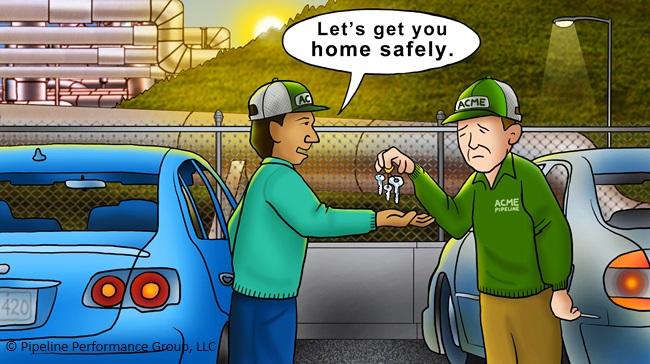Sleepiness can arise any time of day, but for shift workers, incidents of sleepiness may naturally be more common. Sleepiness and fatigue can impact job performance, attention levels, and responsiveness. All of these are of concern when we think about safely operating a pipeline. When the work shift is over and it’s time to head home for rest, it is equally important to be mindful of fatigued or drowsy driving risks. Those who work night and rotating shifts commonly suffer from fatigue and sleep disorders that may contribute to dangerous driving behaviors.
The National Highway Traffic Safety Administration reports three factors most commonly associated with drowsy-driving crashes.[1] First, these crashes frequently occur between midnight and 6 am, or late in the afternoon when circadian rhythm dips are more likely to interfere with alertness. Second, these crashes often involve a driver with no passengers operating their vehicle at a high rate of speed with no evidence of braking. And third, these crashes occur on long stretches of road – both rural roads and highways.
In 2023 the American Automobile Association (AAA) Foundation research reported that drivers may be aware of being drowsy, but they often don’t realize just how tired they are. [2] Three-quarters of drivers who thought they were only mildly tired were, in fact, moderately or extremely drowsy. And even when they were feeling fatigued, 75% declined opportunities to take breaks and kept driving.
Being able to recognize the signs of drowsiness is the first step to reducing your drowsy-driving risk. Drowsiness may present as intense fatigue or yawning, muscle twitching, impaired concentration and memory, slowed reaction times, or even balance and coordination issues. Shift workers should be aware of these signs – either for yourself or a coworker – and take action to address them before getting behind the wheel.
What can be done to reduce the risks of drowsy driving? After a 12-hour shift, we know you just want to get home, so advising you to avoid the drive home is likely not advice you want to hear. One way to mitigate your drowsy-driving risk during these times is to live as close as possible to work (shorten the commute) or consider carpooling with a coworker who shares the same shift rotation. A drink with caffeine a couple of hours before the end of shift might increase alertness for the drive home. If you are really sleepy at the end of a shift, consider taking a 15-20 minute nap before driving home. Be sure to seek medical assistance for any sleep problems you are experiencing. It is easier to reduce drowsy-driving risks if you are able to make the most of your sleep opportunities!
MANAGING FATIGUE EDUCATIONAL PROGRAM
Christina Via © 2024 Please Distribute to Others.
[1] Drowsy Driving, U.S. Department of Transportation National Highway Traffic Safety Administration, accessed May 30, 2024, https://www.nhtsa.gov/risky-driving/drowsy-driving#:~:text=Drowsy%2Ddriving%20crashes:,driving%20when%20you’re%20drowsy.
[2] Gross, A. Asleep At the Wheel: Drivers Unaware of How Drowsy They Really Are (March 3, 2023), AAA Newsroom., Retrieved November 2, 2023 from




